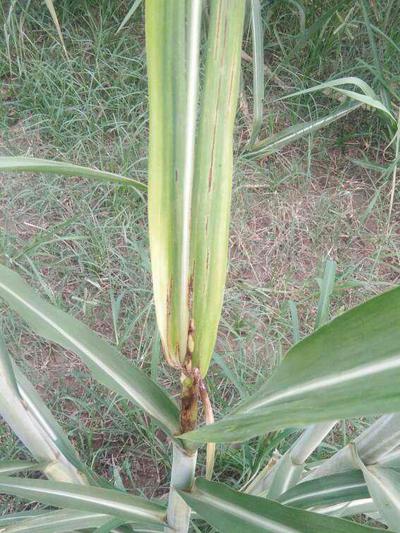Leaf Scald of Sugarcane
Xanthomonas albilineans
Bactérie
En Bref
- Pencil-line streaks on leaf.
- Partial or complete bleaching of the leaf blade.
- Stunted and wilted leaves.
Peut aussi être retrouvé(e) dans
Symptômes
Symptoms include two main forms (chronic or acute) and two stages (latent and eclipse). The chronic forms show lines on leaf blades that run parallel to the ribs. They can be as wide as 1 cm. The acute form shows sudden wilting of mature stalks. There are usually no external symptoms. The disease can be latent, it may not be obvious for some time and the plant is seriously affected when the symptoms first appear. The first sign of the disease is the development of white pencil lines with yellow borders following the veins on the leaf that lead to tissue necrosis. The disease can also cause the shoots to be stunted and wilted. Affected leaves usually turn into dull-blue green colour before dense browning. Under stressful conditions, the whole shoot may die. On mature stalks, spindle leaves become necrotic from the tips and moderate to profuse side shoots develop. Side shoots usually show scalding or white pencil lines.
Recommandations

Contrôle Biologique
Seed cane can be given a long hot water treatment to kill the pathogen. Pre-soak seed cane or cuttings in flowing water followed by a three hour 50°C treatment to clean infected planting material.

Contrôle Chimique
Always consider an integrated approach with preventive measures together with biological treatments, if available. As of today, no chemical control methods have been developed against these bacteria. But you can dip setts in a solution containing carbendazim 5 g in 10 lit of water for 15 minutes after hot water treatment to reduce infestation to a certain level.
Ce qui l'a provoqué(e)
Damage is caused by the bacteria Xanthomonas albilineans. The pathogen survives in cane stubble but does not appear to survive for long periods of time in soil or undecomposed cane trash. The disease spreads mainly through infected setts. Mechanical transmission by harvesting and sett cutting instruments is the most important mode of infection. The disease can also survive in grasses, including elephant grass and can be transmitted from them to sugarcane. Environmental conditions such as drought, waterlogging and low temperatures can increase disease severity.
Mesures préventives
- Introduce only disease-free plant material.
- Control the distribution and exchange of plant materials, especially when cutting.
- Eliminate susceptible varieties during the sugarcane selection process.
- Remove alternative hosts.



